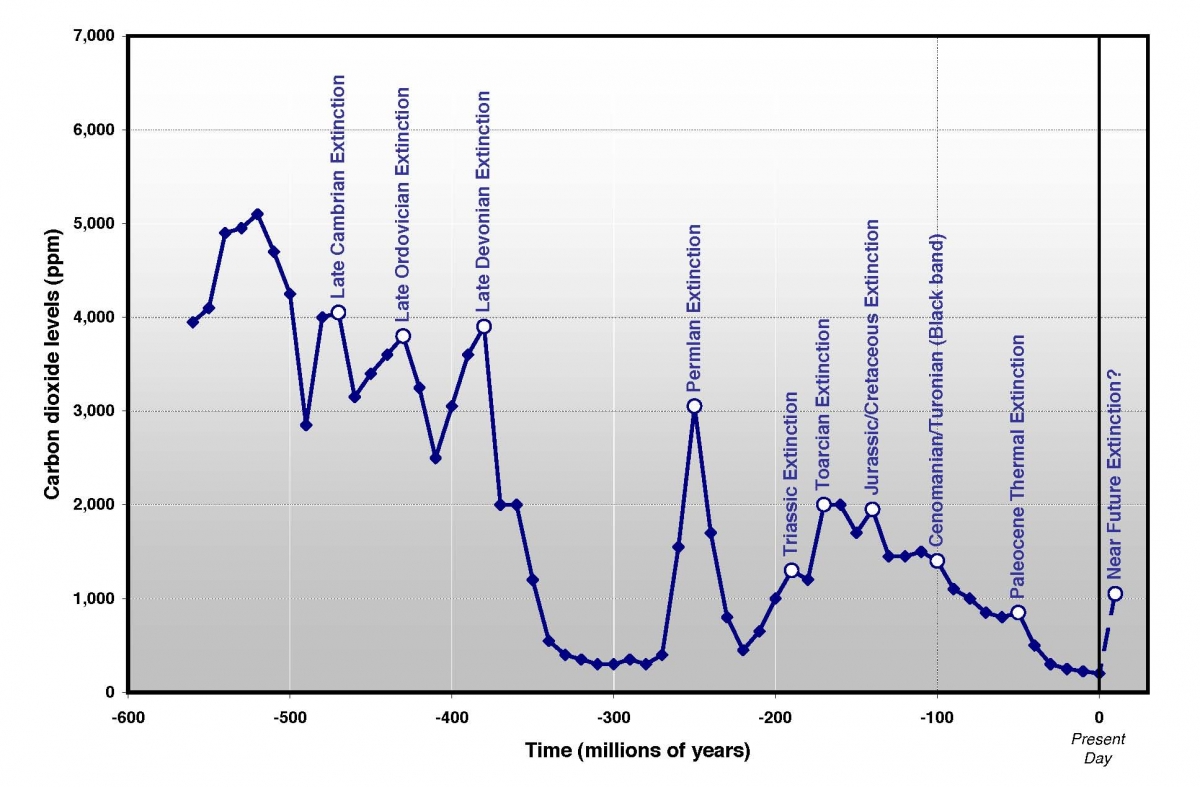Mass Extinctions and CO2 levels
The chart below is adapted from a similar graph in Dr. Peter Ward’s book, “Under a Green Sky.” It plots all the mass extinction events of the last 500 million years against the best estimate of carbon dioxide levels (CO2) at the time. According to his analysis, all major extinctions occurred when CO2 levels exceeded a thousand parts per million (ppm).
This is a fascinating and ominous correlation, which I will explain in a moment. First, a word about Peter and the book cited above. He is well – qualified, beyond being an eminent professor at the University of Washington in Seattle. He has received many honors; was featured on some television shows; gave a talk at the highly reputed TED conferences; and has written 17 books. (Although we have recently become friends, I was a reader and fan for several years prior.)
In “Under a Green Sky” he describes the fascinating detective work, in which he participated, to understand some of the previous mass extinctions. The tedious work to decipher the geologic record in diverse places around the world, becomes an adventure.
The picture that emerges, is that over tens of millions of years, Earth’s climate and life forms have changed dramatically, at times, with different causes or ‘trigger events.’
He proposes that there are two different biologic modes of the planet, over the last few hundred million years. The big distinguishing factor is the state of the ocean, and its biochemistry. At a certain level of temperature and carbon dioxide (CO2) the sea turns purple, with a hydrogen sulfide base. When that happens, a mass extinction occurs. A mass extinction is defined as when more than half the species disappear.
As you will see on that graph, each known mass extinction during the last 550 million years occurred when CO2 levels were over 1,000 ppm. If you want to get an understanding of the connection, and a fascinating understanding of how leading paleontologists decipher the past, I encourage you to get this book.
The cause for concern is that the current CO2 level — more than 390 ppm (parts per million) — is projected to reach a thousand ppm in approximately one hundred years at the current rate of increase. The measurement of CO2 levels has been done with great precision for more than fifty years going back to the legendary work of Dr. Charles David Keeling, on a remote Hawaiian mountain top, to avoid the influence of civilization on the atmosphere. Now those measurements are also done by labs around the world. (I will cover the Keeling curve in a separate post soon.) Back to the question of extinctions and CO2. What is unknown is how quickly such a chain of events (high temperature and CO2 causing the hydrogen sulfide chemistry to take over the seas) could occur.
When people talk about the extinctions of species, and how our environment is changing, sometimes they ask, “Do you think we could go extinct?” Until I read Ward’s book, I would always dismiss that, not wanting to be an alarmist. Now I think differently, and look for a funny or tactful way to sidestep the question — depending on the audience and the situation.
For the truth is that of course we will go extinct — the question is whether that occurs in billions of years, when our sun expands to the point of incinerating life on our planet, or due to some event MUCH sooner. The connection that Peter has now illuminated, puts a very different timescale on the issue. There is a big difference between the possibility of a mass extinction during the next thousand years, or the next billion. As Ward explains, we cannot yet predict how quickly high CO2 levels could change the ocean biochemistry system.
Also it is still hard to project the rate of change for CO2, given the recent and current rapid growth of our emissions, largely from energy production. Dr. James Hansen, a leading climate expert points out that at the current rate CO2 will increase 100 ppm in approximately 40 years. During past periods of abrupt change — the most recent one occurring approximately 50 million years ago — it took roughly a million years for CO2 to change by 100 ppm. Thus it is now changing about 25,000 times faster than at any time in known geologic history.
Unitl now, I thought the primary issues associated with climate change and increasing levels of CO2 were a) how much the CO2 and other greenhouse gases would warm the planet, b) how the warming would melt the ice sheets, causing a major crisis from sea level rise over the next few centuries, and c) the effect of CO2 dissolving in the ocean, causing a drop in pH — known as Ocean Acidification. With this new powerful insight from Dr. Ward, I now add the CO2 itself as a threat even if the timeframe is some unknown number of centuries, or even millennia.
If you are like me, you probably are stunned with this information, and may need to let it sink in. It truly puts a new level of importance on the issue of how high we are willing to let CO2 levels rise, regardless of the cost to solve the challenge, or the impact on short term economics. As they say, extinction is forever. Until now, I never seriously considered that there was even a remote possibility of humans going extinct for hundreds of thousands of years.
Now I see a different reality if we were to foolishly let CO2 levels climb ever upward. Of course at some point necessity and human ingenuity will likely figure out a way to reduce the CO2 levels, so-called “geoengineering.” The challenges, side effects, and unintended consequences of geoengineering are ENORMOUS. We will look at that in another blog post.

